_Chapter
4 - The Basics: Determining a Rating_ |
The previous two chapters
described the base indicators and the additional features of the system (Required
Improvement and the Exceptions Provision). This chapter describes how to use
the indicator data results with the additional features to determine campus
and district ratings. The ratings for the overwhelming majority of campuses
and districts can be determined this way. Some campuses and districts must
be evaluated using different procedures. See Chapter
6 - Special Issues and Circumstances for details about which campuses
and districts are affected and how they are evaluated.
Who is
Rated?
The state accountability
system is required to rate all districts and campuses that serve students
in grades 1 through 12. The first step is to identify the universe of districts
and campuses that can be considered for a rating. For 2005, the universe is
determined to be those districts and campuses that reported students in membership
in any grades (early education through grade 12) in the fall of the 2004-05
school year. The universe is then divided into those campuses and districts
to be evaluated under Alternative Education Accountability (AEA) procedures
(see Part 2 - Alternative Education Accountability (AEA) Procedures)
and those evaluated using standard procedures. Most districts and campuses
identified for standard procedures receive one of the four primary rating
labels (Exemplary, Recognized, Academically Acceptable,
or Academically Unacceptable). Some receive a label of Not Rated.
Rating labels and their uses are described below.
Once the universe of
standard campuses and districts is established, the next step is to determine
if the district or campus has TAKS results on which it can be evaluated. In
order to attain one of the four primary rating labels, districts and campuses
must have at least one TAKS test result in the accountability subset. An effort
is made through the pairing process to supply TAKS results to campuses (with
any grades from 1 to 12) with no students in the grades tested so that they
can also be evaluated. For more information on pairing see Chapter
6 - Special Issues and Circumstances.
Districts and campuses
that have only SDAA II results, only completion rates, only dropout rates,
or only combinations of these three will not receive one of the four primary
ratings in 2005. To be eligible to be Exemplary, Recognized,
Academically Acceptable, or Academically Unacceptable, TAKS
results are required and only TAKS results are required. Districts and campuses
need not have data for the SDAA II, dropout, or completion indicators in order
to receive a rating. Furthermore, performance on any one of the TAKS subjects
is sufficient for a rating to be assigned (science, mathematics, reading/ELA,
writing, or social studies).
Though at least one TAKS
tester (in the accountability subset) is required to be considered for a rating,
some places with very small numbers of total TAKS test results may ultimately
receive a Not Rated label. The process of Special Analysis is employed when
there are very small numbers of total test takers to determine if a rating
is appropriate. See Chapter 6 - Special
Issues and Circumstances for details about Special Analysis.
Standard
Rating Labels
Rating labels for districts
are specified in statute. For 2005, standard campuses and districts will be
assigned one of the following rating labels.
Table
4: Standard Rating Labels
| |
District/Charter
Operator Use |
Campus
Use (non-charter and charter) |
| Exemplary |
Used for districts or charter operators with at least one TAKS test result
(in any subject) in the accountability subset. Small numbers subject to
Special Analysis. |
Used for campuses serving grades 1-12 and with at least one TAKS test result
(in any subject) in the accountability subset. Includes campuses with TAKS
data due to pairing. Small numbers subject to Special Analysis. |
| Recognized |
| Academically
Acceptable |
| Academically
Unacceptable |
| Not Rated:
Other |
Used for
districts or charter operators in the unlikely event that there is insufficient
data to rate due to no TAKS results in the accountability subset. |
Used if
the campus:
- Has no
students enrolled in grades higher than kindergarten.
Has
insufficient data to rate due to no TAKS results in the accountability
subset.
-
Has
insufficient data to rate through Special Analysis due to very small
numbers of TAKS results in the accountability subset.
-
Is a
designated Juvenile Justice Alternative Education Program (JJAEP)
or a designated Disciplinary Alternative Education Program (DAEP).
|
| Not
Rated: Other |
Used
for charters if they are new and would otherwise be rated Academically
Unacceptable.
Used for
districts/charters in the unlikely event that there is insufficient data
to rate due to no TAKS results in the accountability subset. |
Used
if the campus (regular or charter):
- Has no
students enrolled in grades higher than kindergarten.
- Is new
and would otherwise be rated Academically Unacceptable.
- Has insufficient
data to rate due to no TAKS results in the accountability subset.
- Is a
designated Juvenile Justice Alternative Education Program (JJAEP) or
a designated Disciplinary Alternative Education Program (DAEP).
|
| Not Rated:
Data Integrity Issues |
Used
in the rare situation where the accuracy and/or integrity of performance
results are compromised and it is not possible to assign a rating label
based on the evaluation of performance. This label may be assigned temporarily
pending an on-site investigation or may be assigned as the final rating
label for the year.
This rating
label is not equivalent to an Academically Unacceptable rating.
The Commissioner of Education also has the authority to lower a rating
or assign an Academically Unacceptable rating to address problems
with the accuracy and/or integrity of performance results that are discovered
through Accountability System Safeguards, Performance-Based Monitoring,
or other monitoring and compliance reviews.
Data quality
is considered to be a district responsibility. It is possible for a district
rating to be Not Rated: Data Integrity Issues without any of its campuses
having that rating label. If any campus within a district receives a rating
of Not Rated: Data Integrity Issues, then the district's rating will be
affected. The district may receive a rating of Not Rated: Data Integrity
Issues, either temporarily or permanently, or the district's rating could
also be changed to Academically Unacceptable for data quality
reasons.
See Chapter
17 - Responsibilities and Consequences for more information about
the circumstances that trigger this rating label. |
Registered alternative
education campuses will receive ratings under the AEA procedures. See Chapter
13 - AEA Ratings for information on the AEA rating labels.
Notification
of Ratings (August 1, 2005)
Notification of campus
and district accountability ratings will occur on August 1, 2005. This consists
of release of the campus and district data tables and the district summary
reports on TEA's website. Ratings for both standard and registered alternative
education campuses (AECs) will be included.
In 2005 for the first
time, districts will have access to their confidential reports through the
TEA Secure Environment (TEASE) website. For this reason, Education Service
Centers will not be required to distribute reports to districts.
Notification
of Ratings (Late October, 2005)
Accountability ratings
are finalized when the accountability appeals process is completed. Agency
web products related to state accountability (both public and secure sites)
will be updated to reflect the outcome of appeals and to add the Gold Performance
Acknowledgments information in late October, 2005. See Chapter
18 - Calendar and Chapter
16 - Appealing the Ratings for more information.
Using the
Data Table to Determine a Rating
In late July, prior to
finalizing all computations necessary for accountability ratings, TEA will
provide districts with access to preview data tables for the district and
each campus within the district through the TEASE website.
These tables will not
show a rating and will not provide calculations for Required Improvement or
the Exceptions Provision. However, using the data on the tables and the 2005
Accountability Manual, districts can anticipate their ratings in advance of
the TEA ratings release. These preview data tables will contain unmasked data
and must be treated as confidential. That is, information that reveals the
performance of an individual student may be shown.
A sample unmasked preview
data table for a campus serving grades 7-12 is on the following pages. While
not a common configuration, this grade span includes data for all accountability
indicators.
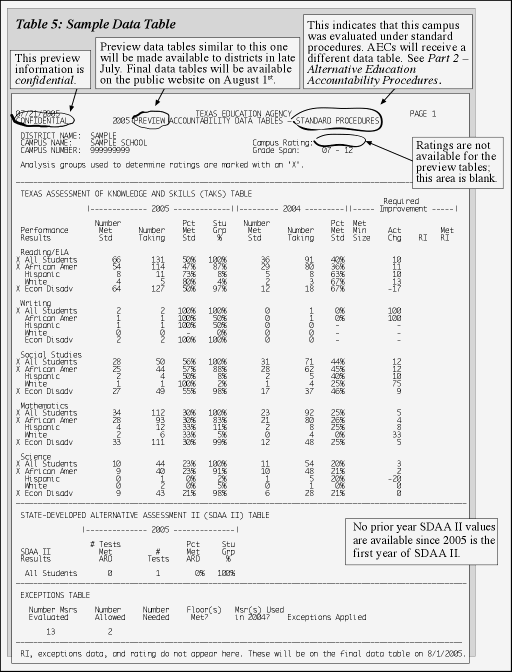
(For
a clearer view of this page, download page 36, a
pdf.)
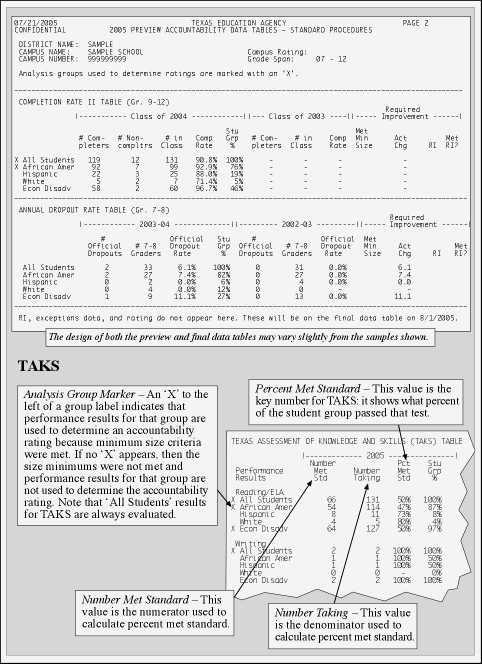
(For
a clearer view of this page, download page 37, a
pdf.)
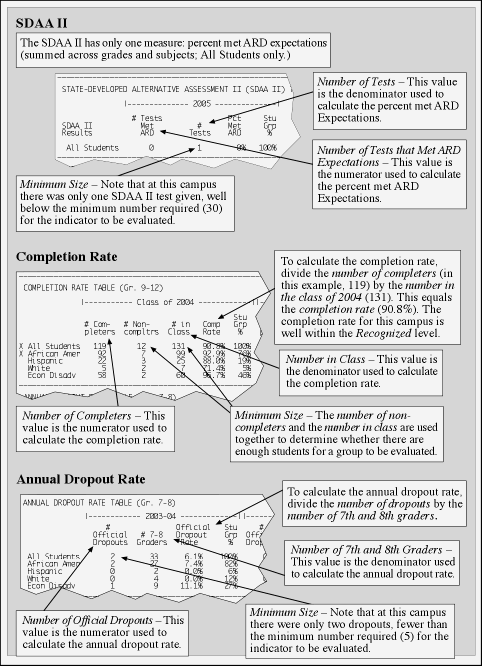
(For
a clearer view of this page, download page 38, a
pdf.)
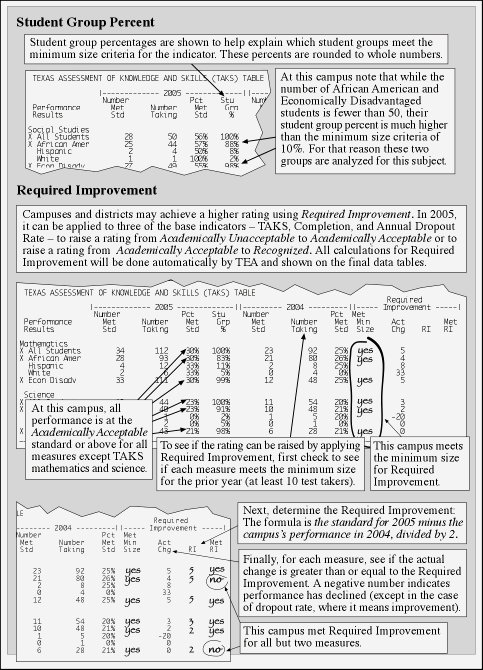
(For
a clearer view of this page, download page 39, a
pdf.)
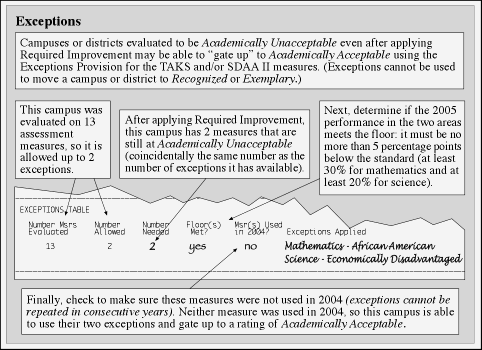
(For
a clearer view of this page, download page 40, a
pdf.)
Additional
Information on August Data Tables
The sample shown is of
a preview data table. These will be made available to districts on the TEASE
website. Data tables with rating labels will be released on August 1, 2005.
The following items are
the additional information not present on the preview, but added to the August
data tables:
- Accountability Ratings.
(A list of possible rating labels is shown in Table 4 in this chapter.)
- Pairing. Any standard
campus with enrollment within grades 1-12, but no students tested on TAKS
will be paired for accountability. A message will indicate the campus it
is paired with.
- Messages. These messages
appear in the top section of the data table when applicable:
- (Special Analysis
Used) (campus or district)
- Rating changed
due to appeal. Data not modified. (campus or district)
- Rating is not
based on data shown in the table. (campus or district)
- District rating
limited to Academically Acceptable due to having one or more
Academically Unacceptable campuses. (district only)
- District rating
limited to Academically Acceptable due to exceeding threshold
for underreported students. (district only)
- Rating changed
after [date] due to Data Integrity Issues. (campus or district)
- Required Improvement.
The final data table shows all calculations for Required Improvement:
- Met Min Size -
Met Minimum Size shows "yes" or "no."
- RI - This shows
the amount of change needed for Required Improvement to be met.
- Met RI - If Required
Improvement is calculated, this shows "yes" or "no"
depending on the comparison of actual change to the change needed (RI).
- Blank - If Required
Improvement is not applicable, the columns are blank.
- Footnotes. A footnote
appears if the Required Improvement floor is not met thus preventing
the use of Required Improvement to change a rating from Academically
Acceptable to Recognized.
- Exceptions. The final
data table shows all calculations for the Exceptions Provision:
- Number Needed
- This shows the number of assessment measures below the Academically
Acceptable standard that did not meet Required Improvement.
- Floor(s) Met?
- This shows "yes" or "no" depending on whether
or not the performance floor was met for all the assessment measures
needing exception. If any don't meet the floor, "no" appears.
- Measure(s) Used
in 2004? - The same exception cannot be used in consecutive years. This
shows "yes" or "no" depending on whether or not
any of the exceptions needed in 2005 were used in 2004.
- Exceptions Applied
- This shows the subject and group for which an exception is used. Up
to three may be listed.
- Blank - If the
Exceptions Provision is not applicable, only the Number Measures Evaluated
and Number Allowed columns show a number, other areas are blank.
Masked Data
As in the past, performance
on the data tables posted to the agency's public website is masked when there
are fewer than five students in the denominator of the measure. Additionally,
all performance at or near 0% or 100% is also masked. It is necessary to mask
data that potentially reveals the performance of every student in order to
be in compliance with the federal Family Educational Rights and Privacy Act
(FERPA).
System
Summary
The following two tables
summarize the 2005 system. Table 6 provides an overview of the requirements
for each rating level. A district or campus must meet the criteria for every
applicable measure to be rated Exemplary, Recognized, or
Academically Acceptable; otherwise the next lower rating is assigned.
The Exceptions Provision
can elevate to a rating of Academically Acceptable but no higher.
Districts must meet two
additional provisions at the Recognized and Exemplary rating
levels: checks for Academically Unacceptable campuses and excessive
underreported students.
Table 7 is a single-page
overview that provides details of the 2005 system, with the base indicators
listed as columns. For each of the indicators, users can see brief definitions,
the rounding methodology, the accountability subset methodology, the standards,
minimum size criteria, subjects and student groups used, application of Required
Improvement, and the Exceptions Provision.
Table
6: Requirements for Each Rating Category
| |
Academically
Acceptable |
Recognized |
Exemplary |
| Base
Indicators |
| Spring
2005 TAKS
- All students
- and each
student group meeting minimum size:
- African
American
- Hispanic
- White
- Econ.
Disadv.
|
meets
each standard:
- Reading/ELA
50%
- Writing
50%
- Social
Studies 50%
- Mathematics
35%
- Science
25%
OR meets Required
Improvement |
meets
70% standard for each subject
OR
meets 65% floor and Required Improvement
|
meets
90% standard for each subject |
| Spring
2005 SDAA II
All students
(if meets minimum size criteria)
|
meets
50% standard
(Met ARD Expectations)
|
meets
70% standard
(Met ARD Expectations)
|
meets
90% standard
(Met ARD Expectations)
|
| Completion
Rate II (class of 2004)
|
meets
75.0% standard
OR
meets Required Improvement
|
meets
85.0% standard
OR
meets 80.0% floor and Required Improvement
|
meets
95.0% standard
|
| Annual
Dropout Rate 2003-04
|
meets
1.0% standard
OR
meets Required Improvement
|
meets
0.7% standard
OR
meets 0.9% floor and Required Improvement
|
meets
0.2% standard
|
| Additional
Provisions |
| Exceptions |
Applied if district/campus would be Academically Unacceptable due
to not meeting the Academically Acceptable criteria on up to 3
test measures. (See detailed explanation.) |
Exceptions cannot be used to move to a rating of Recognized. |
Exceptions cannot be used to move to a rating of Exemplary. |
|
Check for Academically Unacceptable Campuses
(District only) |
Does not apply to Academically Acceptable districts. |
A district with a campus rated Academically Unacceptable cannot
be rated Recognized. |
A district with a campus rated Academically Unacceptable cannot
be rated Exemplary. |
|
Underreported Students: (District only) |
Does not apply to Academically Acceptable districts. |
A district that underreports more than 100 students or more than 5.0% of
its prior year students cannot be rated Recognized. |
A
district that underreports more than 100 students or more than 5.0% of its
prior year students cannot be rated Exemplary. |
Table
7: Overview of 2005 System Components
| |
TAKS |
SDAA
II |
Completion
Rate II |
Dropout
Rate |
| Definition |
TAKS results
(gr. 3-11) summed across grades by subject. Reading & ELA results are
combined. Cumulative results used for first 2 admins of gr. 3 reading, gr.
5 reading, and gr. 5 math. Student passing standard is at panel recommendation
for gr. 3-10; 1 SEM for gr. 11. |
A single
(gr. 3-10) indicator calculated as the number of tests meeting ARD expectations
(summed across grades & subjects) divided by the number of SDAA II tests. |
Graduates,
GED recipients, and continuers expressed as a % of total students in the
class. Campuses serving any of gr. 9-12 w/out a completion rate are assigned
the district completion rate. |
Gr. 7 and
8 official dropouts as a percent of total gr. 7 and 8 students who were
in attendance at any time during the school year. |
| Rounding |
Whole
Numbers |
Whole
Numbers |
One
decimal |
One
decimal |
Standards
Exemplary
Recognized
Acceptable
|
Ex.: All
Subjects ≥ 90%
Re.: All Subjects ≥ 70%
Acc.: Rdg/ELA/W/SS ≥ 50%
Mathematics ≥ 35%
Science ≥ 25% |
Ex.: ≥
90%
Re.: ≥ 70%
Acc.: ≥ 50% |
Ex.: ≥
95.0%
Re.: ≥ 85.0%
Acc.: ≥ 75.0% |
Ex.: ≤
0.2%
Re.: ≤ 0.7%
Acc.: ≤ 1.0% |
Mobility
Adjustment
(Accountability Subset) |
District
ratings: results for students enrolled in the district in the fall
and tested in the same district.
Campus
ratings: results for students enrolled in the campus in the fall
and tested in the same campus.
|
None |
None |
| Subjects |
Reading/ELA
Writing
Mathematics
Social Studies
Science
|
Reading/ELA
Writing
Mathematics
n/a
n/a
|
n/a |
n/a |
| Student
Groups |
All
& Student Grps:
African American
Hispanic
White
Econ. Disadv.
|
All
Students Only |
All
& Student Grps:
African American
Hispanic
White
Econ. Disadv. |
All
& Student Grps:
African American
Hispanic
White
Econ. Disadv. |
|
Minimum Size Criteria |
All |
No
minimum size requirement-special analysis for small numbers |
30
or more tests |
≥
5 dropouts
AND
≥ 10 students |
≥
5 dropouts
AND
≥ 10 students |
| Groups |
30/10%/50 |
n/a |
≥
5 dropouts
AND
30/10%/50 |
≥
5 dropouts
AND
30/10%/50 |
| Required
Improvement (RI) |
Actual
Chg |
2005
minus 2004 performance (@ 2005 passing std) |
n/a |
Class
of 2004 rate minus Class of 2003 rate |
2003-04
rate minus 2002-03 rate |
RI |
Gain needed to reach standard in 2 yrs. |
n/a |
Gain needed to reach standard in 2 yrs. |
Decline needed to reach std. in 2 yrs. |
Use |
Gate
up to Acceptable and Recognized |
n/a |
Gate
up to Acceptable and Recognized |
Gate
up to Acceptable and Recognized |
Floor
(Recognized) |
at
least 65% |
n/a |
at
least 80.0% |
≤
0.9% |
Minimum
Size |
Meets
minimum size in current year and has ≥ 10 students tested in prior
year. |
n/a |
Meets
minimum size in current year and has ≥ 10 students in completion
class the prior year. |
Meets
minimum size in current year & has ≥ 10 7th-8th grade students
the prior yr. |
| Exceptions |
After application of RI, this provision may be applied if the campus or
district would be Unacceptable solely due to not meeting the
Acceptable criteria on up to 3 assessment measures. Applies to 26 measures
- 25 TAKS (5 subjects x 5 groups) plus the SDAA II measure. |
n/a |
n/a |
Use |
As
a gate up to Acceptable
|
n/a |
n/a |
| Floor |
No
more than 5 percentage points below Acceptable std.
|
n/a |
n/a |
Number
of Exceptions Allowed (variable) |
#
of Assessment Measures
Evaluated (at campus or district) |
Maximum
Exceptions
Allowed |
1
- 5
6 - 10
11 - 15
16 - 26 |
0
1
2
3 |
|
n/a |
n/a |
Accountability
2005 | Accountability
| Performance Reporting
| TEA Home




